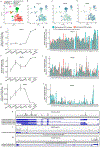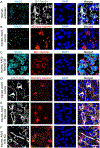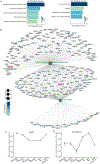Nfe2l3 promotes neuroprotection and long-distance axon regeneration after injury in vivo
- PMID: 38395216
- PMCID: PMC10981571
- DOI: 10.1016/j.expneurol.2024.114741
Nfe2l3 promotes neuroprotection and long-distance axon regeneration after injury in vivo
Abstract
Nuclear factor erythroid 2 like (Nfe2l) gene family members 1-3 mediate cellular response to oxidative stress, including in the central nervous system (CNS). However, neuronal functions of Nfe2l3 are unknown. Here, we comparatively evaluated expression of Nfe2l1, Nfe2l2, and Nfe2l3 in singe cell RNA-seq (scRNA-seq)-profiled cortical and retinal ganglion cell (RGC) CNS projection neurons, investigated whether Nfe2l3 regulates neuroprotection and axon regeneration after CNS injury in vivo, and characterized a gene network associated with Nfe2l3 in neurons. We showed that, Nfe2l3 expression transiently peaks in developing immature cortical and RGC projection neurons, but is nearly abolished in adult neurons and is not upregulated after injury. Furthermore, within the retina, Nfe2l3 is enriched in RGCs, primarily neonatally, and not upregulated in injured RGCs, whereas Nfe2l1 and Nfe2l2 are expressed robustly in other retinal cell types as well and are upregulated in injured RGCs. We also found that, expressing Nfe2l3 in injured RGCs through localized intralocular viral vector delivery promotes neuroprotection and long-distance axon regeneration after optic nerve injury in vivo. Moreover, Nfe2l3 provided a similar extent of neuroprotection and axon regeneration as viral vector-targeting of Pten and Klf9, which are prominent regulators of neuroprotection and long-distance axon regeneration. Finally, we bioinformatically characterized a gene network associated with Nfe2l3 in neurons, which predicted the association of Nfe2l3 with established mechanisms of neuroprotection and axon regeneration. Thus, Nfe2l3 is a novel neuroprotection and axon regeneration-promoting factor with a therapeutic potential for treating CNS injury and disease.
Keywords: Axon regeneration; Gene therapy; Optic nerve injury; Retinal ganglion cell.
Copyright © 2024 Elsevier Inc. All rights reserved.
Conflict of interest statement
Declaration of competing interest The authors declare no competing interests.
Figures







Similar articles
-
Augmenting fibronectin levels in injured adult CNS promotes axon regeneration in vivo.Exp Neurol. 2024 Sep;379:114877. doi: 10.1016/j.expneurol.2024.114877. Epub 2024 Jun 27. Exp Neurol. 2024. PMID: 38944331 Free PMC article.
-
Experimental gene expression of developmentally downregulated Crmp1, Crmp4, and Crmp5 promotes axon regeneration and retinal ganglion cell survival after optic nerve injury.Brain Res. 2023 Jun 15;1809:148368. doi: 10.1016/j.brainres.2023.148368. Epub 2023 Apr 12. Brain Res. 2023. PMID: 37059258 Free PMC article.
-
KLF9 and JNK3 Interact to Suppress Axon Regeneration in the Adult CNS.J Neurosci. 2017 Oct 4;37(40):9632-9644. doi: 10.1523/JNEUROSCI.0643-16.2017. Epub 2017 Sep 4. J Neurosci. 2017. PMID: 28871032 Free PMC article.
-
Retinal Ganglion Cell Survival and Axon Regeneration after Optic Nerve Injury: Role of Inflammation and Other Factors.Int J Mol Sci. 2022 Sep 5;23(17):10179. doi: 10.3390/ijms231710179. Int J Mol Sci. 2022. PMID: 36077577 Free PMC article. Review.
-
Neuro-protection and neuro-regeneration of the optic nerve: recent advances and future directions.Curr Opin Neurol. 2020 Feb;33(1):93-105. doi: 10.1097/WCO.0000000000000777. Curr Opin Neurol. 2020. PMID: 31809331 Free PMC article. Review.
Cited by
-
New insight into the CNC-bZIP member, NFE2L3, in human diseases.Front Cell Dev Biol. 2024 Jul 23;12:1430486. doi: 10.3389/fcell.2024.1430486. eCollection 2024. Front Cell Dev Biol. 2024. PMID: 39149514 Free PMC article. Review.
-
Neuroprotective Effect of Methylene Blue in a Rat Model of Traumatic Optic Neuropathy.Pharmaceuticals (Basel). 2025 Jun 19;18(6):920. doi: 10.3390/ph18060920. Pharmaceuticals (Basel). 2025. PMID: 40573315 Free PMC article.
References
MeSH terms
Grants and funding
LinkOut - more resources
Full Text Sources
Medical
Molecular Biology Databases
Research Materials

